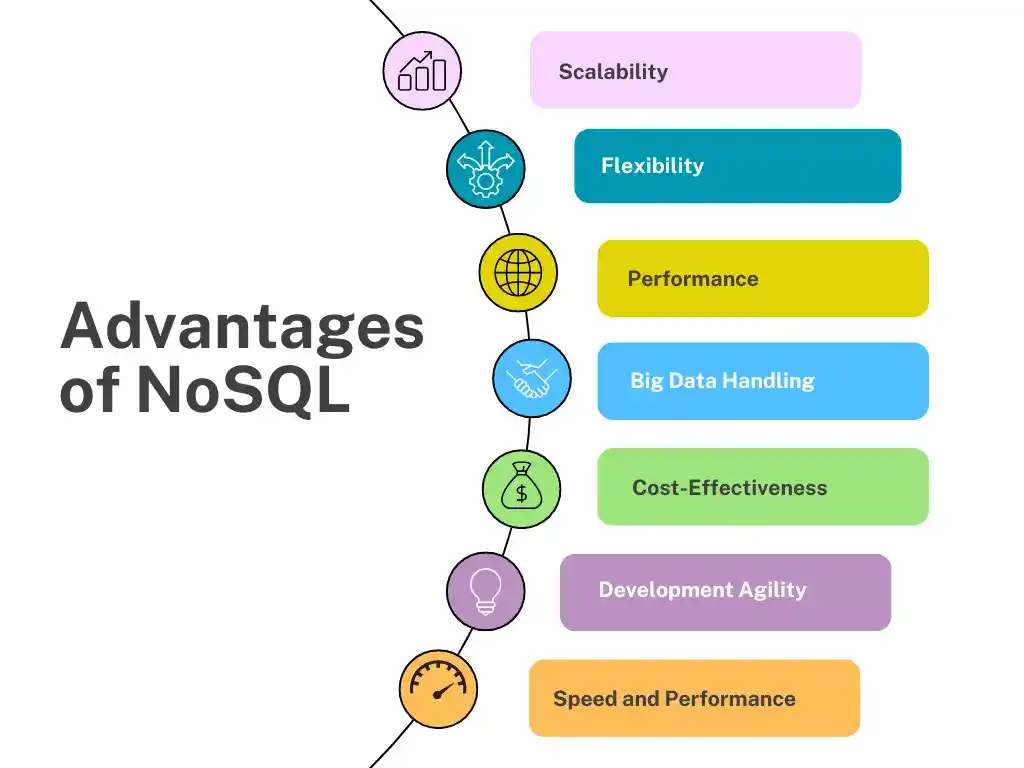Until now, a basic form of data storage has dominated the world of data: the relational database. But with the rise of big data and ever-evolving applications, a new challenge emerged: NoSQL. It’s time to look at the advantages and disadvantages of NoSQL databases to determine whether they’ll suit your project.
What is NoSQL?
No SQL is today’s data storage technology for large scale data.It is great at distributed processing, and works with huge tables and mixed row/columnar structures due to ACID-compliant horizontal scalability and schema flexibility.This makes them especially suitable for usage in real-time-web applications and big data processing services.But data consistency and indeed application transactions can be slightly more challenging with NoSQL.
What are the Applications of NoSQL?
NoSQL thrives in big data environments:
- Big Data Management: Stores and analyzes massive, varied data sets (social media, sensor data).
- Real-Time Apps: More used in online gaming, stocks price change, and chatting applications.
- E-commerce & Content: Maintains product catalogues, user information registers, and other information (descriptions, images and commentsetc).
- Social Networking: Processes large volume of social media content (usergenerated posts, comments, connection, photos, and videos).
- IoT: Subscribes and stores data feeds originating from millions of smart devices.
- Mobile Apps: Enhances data access speed as well as the offline handling of data in mobile applications.
Advantages of NoSQL

1. Scalability
Limitless Horizontal Scaling
- In contrast to conventional databases that have restrictions on the growth verticals, NoSQL adeptly handles the growth horizontones. Due to the expansion of NoSQL databases through a cluster compound that allows for the addition of more servers to address the constant growth in the numbers and traffic of data and users, NoSQL databases can scale infinitely.
- This makes them suitable to scale as they need to be with numerous web applications or real-time data where the expands constantly and at its optimal.
Elastic Scalability
- When integrated, NoSQL databases include apposite such as flag and alias table outcomes to enable the fast optimization of queries in large databases. This means that they are well suited to data analytical work for the reason that they can easily and quickly perform specific data calls.
2. Flexibility
Schema-less Design
- Schema-less Design, similar to what is stated before, NoSQL does not require the structured schema typical in use with relational databases. And while it is good at handling tabular data, it is much more versatile, offering the possibility to store any data in any structure, structured, or unstructured. This makes it suitable for scenarios such as growing data or when the structure of the data isn’t established well.
Dynamic Data Models
- These can be different, document, key-value, graph, etc They give developers the flexibility to work with the model they find most appropriate. Based on the different types of data needed in a development project, developers select the most appropriate one.
3. Performance
- High Throughput– NoSQL databases are designed mainly for read/write operations. This translates in to positive results of; higher data transfer rates and lesser latencies which make them perfect for uses in applications that require real time data processing such as large web platforms and big data processing.
- Efficient Query Processing– While consolidated, NoSQL databases incorporate apposite such as flag and alias table outcomes to allow for swift and efficient query processing, even for large databases. This means that they are well suited to data analytical work since they are capable of handling quick and efficient retrieval of specific data.
4. Big Data Handling
- Volume and Variety– NoSQL databases are especially suited to handle the big data application. They are intrinsically designed to deal with sizable amounts of data, regardless of the format – structured or unstructured, or semi-structured data.
- Distributed Computing– NoSQL databases work very well with distributed computing protocols. This also makes it easy to process large data since a number of tasks are performed in parallel in a node within the system.
5. Cost-Effectiveness
- Commodity Hardware– NoSQL databases can run on commodity hardware. This results in much smaller cost in infrastructure than would be needed for the high end silicon needed to support increases in traditional SQL database norms.
6. Speed and Performance
- High-Performance Architecture-NoSQL equipments offer a sense of performance than relational Systems specially in the regions of writing and the simplest of searches. This is due to their simple schema free from join and data normalization seen in SQL databases and marked data structures. This makes them suitable for use in applications that require real time response to data processing and retrieval.
7. Development Agility
- Agile Development– The inherent simplicity of NoSQL databases fosters faster development cycles. Developers spend less time wrestling with rigid schema design and more time focused on building the core functionalities of the application. This translates to quicker time-to-market and increased development efficiency.
Disadvantages of NoSQL
1. Complexity
- Learning Curve– For developers and administrators accustomed to the familiar world of relational databases, NoSQL can present a steeper learning curve. The paradigm shift from structured schema to flexible models, along with the diversity of NoSQL query languages, can require additional training and adaptation.
- Query Languages– Not like all can understand SQL, there is an added challenge in NoSQL querying. Every form of NoSQL, document, key-value, or graph, typically employs its own methods of query languages and API. This can require, more learning and adjustment for developers used to the rigid world of SQL.
2. Consistency Challenges
- Eventual Consistency– Many NoSQL databases support Eventual Consistency rather than Consistency. This means that after a write operation, there may be a slight delay before all replicas of the data across the system are updated. This is beneficial in the sense that availability and performance are both high, however, for a short period of time the data in the warehouse can become stale which might not be ideal for ITEs that require real-time information.
- ACID Transactions (Sometimes)– On the other hand, NoSQL is not very good when it comes to handling lots of transactions. While, unlike SQL databases, where ACID properties (Atomicity, Consistency, Isolation, Durability) are provided by default, with NoSQL it may be a problem. This can create difficulties under cases where the data should be kept consistent under strict transactional control to be applied in financial or inventory control systems.
3. Limited Tooling and Ecosystem
- Fewer Tools– The NoSQL world compared to SQL is somewhat young. This results in reduced choices of available tools for development, monitoring, and management duties. And even though the amount of new players is growing extremely fast, developers may have to use a wider pool of open source technologies than for more standardized SQL penspark.
- Vendor Lock-in– Attempts to be loyal to a given vendor crafts a rigid agreement since changing vendors can be a very unmanageable process due to the fact of changes in data models and even changes within the system. Be sure to weigh the inherent risks of periodically archiving large amounts of data and make sure your chosen NoSQL vendor is firmly committed to a strict adherence to open standards, to ensure you’re not locked into a platform you’ll later regret.
4. Less Mature Technology
- Stability and Reliability– Compared to the battle-tested world of SQL databases, some NoSQL solutions are still evolving in terms of stability and reliability. While unlikely, there’s a potentially higher risk of data loss or corruption in extreme circumstances. For mission-critical applications requiring maximum uptime and data integrity, a well-established SQL database might be a safer choice.
- Community and Support– While the NoSQL community is vibrant and growing, it may not yet offer the same level of extensive support and documentation as the well-established SQL community. This can pose challenges for developers seeking troubleshooting assistance or in-depth learning resources for specific NoSQL platforms. Carefully evaluate the available community forums, documentation, and professional support options offered by your chosen NoSQL vendor to ensure you have the resources needed to navigate potential issues and optimize your database use.
5. Compatibility Issues
- Integration with Existing Systems– NoSQL’s strength in flexibility can also present challenges when integrating with existing systems. Seamlessly connecting NoSQL databases to legacy systems or applications designed for SQL can be complex. Data format conversions and custom development work might be necessary to bridge the gap between the two worlds. Carefully evaluate your existing data infrastructure and choose a NoSQL solution that offers robust integration options or consider potential workarounds before migrating.
- Data Migration– Transitioning from the familiar world of relational databases to NoSQL can involve a complex data migration process. Careful planning and meticulous execution are paramount to ensure a smooth transfer of your data. This can be a time-consuming endeavour, requiring data format conversion, schema mapping, and potential downtime during the migration. Carefully weigh the benefits of NoSQL against the complexity of data migration before making the switch.
Conclusion
The world of data storage is no longer a one-size-fits-all proposition. Relational databases, while tried and true, can struggle to keep pace with the ever-growing demands of modern applications. NoSQL databases emerged as a compelling alternative, offering limitless horizontal scaling, schema-agnostic design, and optimized throughput for real-time data processing. However, NoSQL also presents its own set of considerations. Eventual consistency, limited transactional support, and a maturing development ecosystem are important factors to weigh when making your decision.
By carefully considering the advantages and disadvantages of NoSQL, you can make an informed decision and ensure your data has a powerful and flexible home that can grow and adapt alongside your application.





